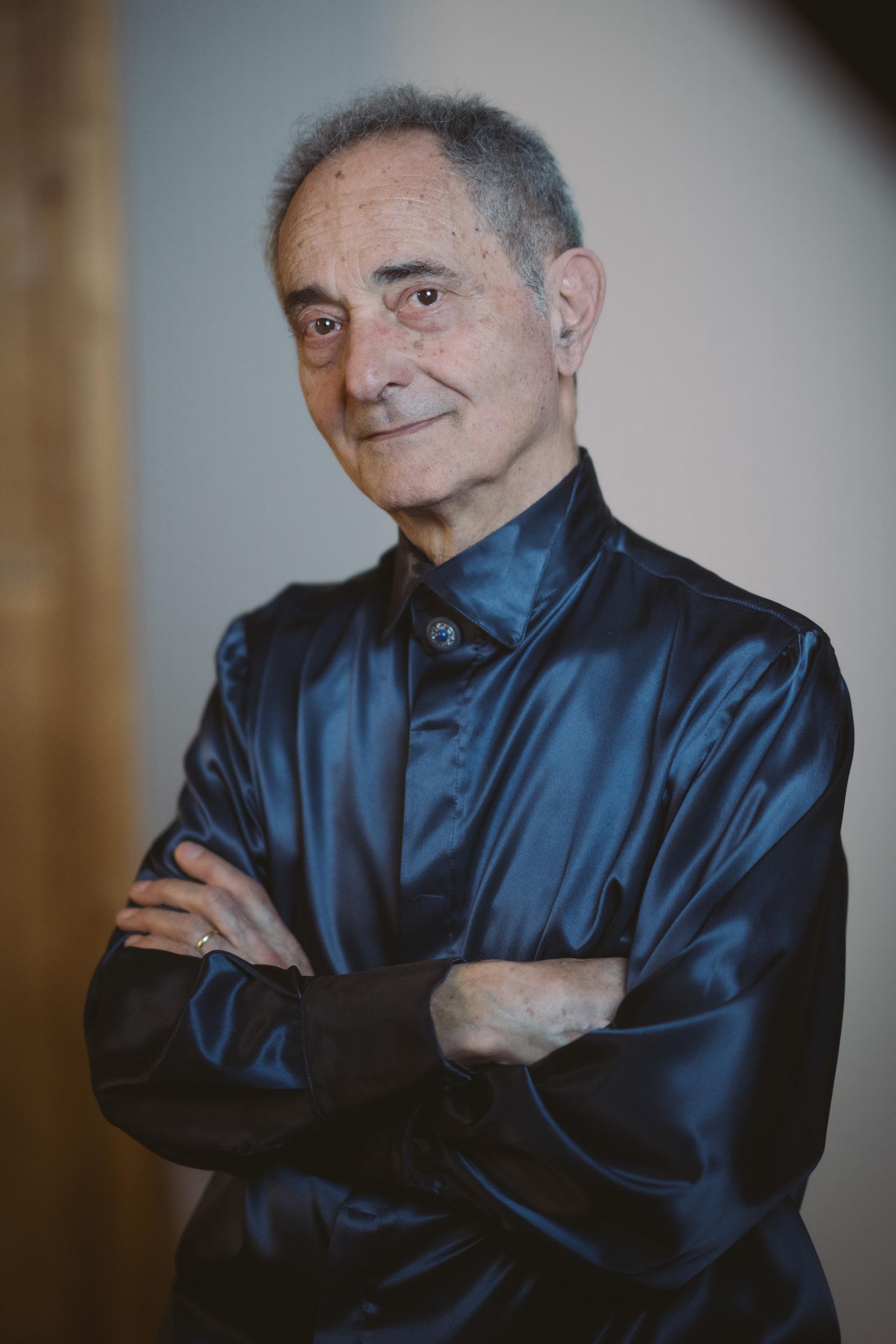

BRAIDS
SERGIO PATRIA
VIOLONCELLO
ELENA BALLARIO PIANO
FRÉDÉRIC CHOPIN (1810-1849)
CELLO SONATA IN G mINOR, OP. 65 (1846/47)

LÉON BOËLLmANN (1862-1897)
CELLO
CLAUDE DEBUSSY (1862-1918) CELLO SONATA IN D mINOR, L. 135 (1915)
tot A l P l Ay time: 68'04














Braids is the theme threaded through what we hope is an incisive and diverse cross-section of three admirable works from the French chamber music repertoire.
Braids has several meanings for us, perhaps especially the entanglement of our lives, dating back to 1986, when the powerful force of sentiment and music united our destinies in an unbreakable plait that has been woven into our life together ever since. A 37-year career marked by many duo concerts and chamber music projects extended to collaborations with actors and opera singers, often springing from the inexhaustible and fervid creativity that has allowed us, in addition to our personal relationship, to express ourselves and renew ourselves with continuity through the beauty of music.








This premise also has its manifestation in Braids, a project in which the cello and piano find their common interpretation of French repertoire in the musical weave of the album. Léon Boëllmann’s Sonata Op. 40 has been part of our repertoire since 2015, yet is still infrequently performed in concert halls in general. It was released on record in 2012 by André Navarra (1911–1988), with whom Sergio intertwined his artistic life, specialising at the Accademia Chigiana in Siena; and despite that beautiful interpretation, this valuable work did not arouse much interest from those in the industry.







Boëllmann’s splendid Op. 40 is placed at the centre of this release to underline its dominant significance and reflect our intention to bring it the honour it deserves, and with which it is appreciated by our concert hall audiences. The choice to precede it with Frédéric Chopin’s Sonata Op. 69 is motivated by their interweaving group of composers, dedicatees and pupils, whereas the styles of the two works have little in common: Chopin reflects full Romanticism while Boellmann turns to Impressionism, hence the trait d’union with the choice to conclude with Debussy’s Sonata in D minor.










Sergio Patria and Elena Ballario




















In the mid-19th century, Paris welcomed a large number of artists, writers and musicians, among them Frédéric Chopin, who lived the golden years of his life in the capital from 1831 to 1849, the year of his death. Chopin’s relationship with the cello came about early in his career when the Austrian cellist Joseph Merk caught his attention. Chopin dedicated the Introduction and Polonaise Brillante Op. 3 published in 1831 to Merk, and described Merk’s playing as “so full of soul. He is the only cellist I truly respect”. This opinion soon changed when, in 1832, Chopin met the cellist and composer Auguste Franchomme in the French capital. The two were introduced by Franz Liszt at a dinner party and Chopin was immediately drawn to Franchomme, with whom he had much in common. The slender 21-year-old was a professional instrumentalist but not a virtuoso and, like Chopin, rejected exhibitionism both musically and socially. After dinner with Liszt, the evening continued at Chopin’s house where Franchomme heard him at the piano and “understood him immediately”.








Their connection became a true friendship: Franchomme visited Chopin almost every day, often in the company of Liszt, who played Chopin’s Études for them. When Liszt’s mistress, the Comtesse d’Agoult, invited Chopin to spend the summer of 1833 at her estate, he chose instead to stay with Franchomme’s family near Tours. Franchomme was also present on the evening of 8 May 1838 when, during a Parisian soirée, the writer George Sand became infatuated with Chopin. Franchomme was among Chopin’s most loyal friends until his death in 1849 and, at the composer’s request, played music by Mozart to him on his deathbed.






Chopin wrote the Sonata for Piano and Cello (in that order) for Franchomme between 1845 and 1846, when he was already frail from tuberculosis and spent many evenings in Paris with his friend working on the Sonata. In April, Chopin stayed again with Franchomme’s family near Tours, but by the summer of that year, having moved to George Sand’s house in Nohant, he was increasingly weak and struggling to compose. Chopin wrote to Franchomme, probably about the Sonata Op. 65, which was still unfinished: “I do all I can to work, but it is no use. If it goes on like this, my new compositions will not resemble the chirping of warbles or even the sound of breaking china”.








It is possible that this self-critical attitude influenced Chopin’s decision to omit the discursive opening movement from a performance of the Sonata Op. 65 at his last Paris concert in 1848 (or perhaps he considered it too complex for a salon audience). The piano unfurls an elegant, contemplative opening theme before giving way to an explosion of virtuosity. By the end of the movement, the material is exhausted and the death
















knell is sounded by two final chords. The Scherzo is a lively dance in a minor key, while the Largo is a beautiful, concise oasis of tranquillity and expressivity. The Finale, like the opening movement, winds through a series of materials, resembling a complex tarantella. The concert in which the Sonata was first performed elicited an enthusiastic reaction from the public and critics alike. The Marquis de Custine wrote to Chopin: “You have gained in suffering and poetry; the melancholy of your compositions penetrates even deeper into the heart; one feels alone with you in the midst of the crowd; it is no longer a piano, but a soul, and what a soul!”. Subsequently, however, the work was not considered fully convincing due to its harmonic complexity and extensive use of counterpoint, but the faithful Franchomme always defended the score and today the Sonata has achieved its rightful place in the 19th-century repertoire.




















Franchomme’s legacy is also palpable in the Sonate pour Piano et Violoncelle, Op. 40 by Léon Boëllmann, who dedicated the work to cellist and teacher Jules Delsart, one of Franchomme’s pupils. But while Delsart and Franchomme were prominent figures at the Paris Conservatoire (Delsart succeeded Franchome as professor of cello), Boëllmann instead attended the École Niedermeyer, founded by Louis Niedermeyer with the intention of training organists and choral conductors. Boëllmann studied with Eugène Gigout – he married his teacher’s niece, Louise Lèfevre – and became organist at the church of St-Vincentde-Paul. He was an outstanding improviser and composer of works for the organ, but died tragically too young at the age of 35; when Boëllmann’s wife died a year later, Gigout raised their three orphans. Boëllmann’s beautiful Sonata for Cello and Piano in A minor (ca. 1897) shows, with its remarkable, almost Wagnerian harmonic fluidity, the influence of the great French organist César Franck, who was inspired by Wagner and whose Sonata for Violin was arranged for cello by Delsart. Boëllmann’s Sonata Op. 40 is characterised by two main features: virtuosic writing and the use of modal inflections. The introduction of the first movement opens with a magnificent cadenced cello phrase and deep piano writing, after which the movement takes off into a brilliant dance, with a development section exploring the harmonic implications of the introductory material. The slow movement has a rather improvised and restless quality, the cello lines resembling a recitative, temporarily placated by the dreamlike serenity of the middle section. The finale has predominantly fast-paced rhythmic characteristics with elements of both modal and chorale writing, before the minor key of the introduction prevails and the work concludes in A minor. Despite his passion for the organ, Boëllmann wrote several works for cello: one of his two published orchestral compositions are the Variations symphoniques for cello and orchestra, as well as a Suite for cello and piano.
























Claude Debussy’s Sonata for Cello and Piano was composed in 1915, towards the end of his life, just after the outbreak of the First World War, an event that had a devastating effect on his mental state. He wrote: “I am just a small atom crushed in this terrible cataclysm. What I am doing seems so miserably small to me”, and added: “I would like to write a ‘Marche Héroïque’... but I must say that I consider it ridiculous to indulge in heroism, in all tranquillity, well out of reach of bullets”.








Debussy never recovered from the impact of the war and became seriously ill with cancer. His former joie de vivre was replaced by introspection, a change that is reflected musically in the Sonata for Cello and Piano. Milhaud visited Debussy at that time: “I saw the master whom I admired so much. He was ill with the terrible illness that led to his death two years later. He was very pale, with a small shawl over his shoulders, and his hands trembled on the piano”. Debussy had planned to compose six sonatas (“I still have much to say,” he wrote), but managed to compose three. The Sonata in D minor contains allusions to earlier pieces, such as the piano prélude La cathédrale engloutie (1910), and draws inspiration from the Commedia dell’Arte; Debussy even thought of calling the piece Pierrot mad at the moon.














Throughout the work, cello and piano are judiciously balanced; the indication remains on the score: “Que le pianiste n’oublie jamais qu’il ne faut pas lutter contre le violoncelle, mais l’accompagner” (May the pianist never forget that he must not fight the cello, but accompany it). The ‘Prologue’ sets the tone for the entire work: the cello remains in a pleasant, colloquial character, with spontaneous changes of tempo and mood, and its mercurial words are punctuated and anchored by the piano’s resolute chords. The ‘Serenata’ begins with a stuttering pizzicato and abrupt piano gestures, as if the performer were tuning a guitar or clearing his throat. Hesitant motifs suggest a long preamble before the Serenade comes into its own with longer-breathed phrases, although the effect of hesitation and stalling is never entirely lost.










In the ‘Finale’ the cello can finally sing, but Pierrot’s pizzicati continue to intervene, reminding us that this tragicomic figure, foremost in the composer’s mind when he wrote the piece, is never far away.
Joanna Wyld


























Sergio Patria, a leading name on the international cello scene both in concert and teaching, made his debut as a soloist with the Orchestra della Radio Svizzera Italiana at the age of 16. He graduated with full marks from the Conservatory of Alessandria with Roveda, subsequently perfecting his skills with Navarra at the Accademia Chigiana in Siena, and Baldovino and Selmi at the Accademia di Santa Cecilia in Rome. He was principal cellist with the Bogotá Symphony Orchestra, and then collaborated with the Orchestra di Santa Cecilia in Rome and as principal cello at the Stadttheater in Lucerne, where he was subsequently invited to be a member of the prestigious orchestra of the Internationalen Musikfestwochen Luzern for several years. In 1974 he won the Migros Prize (Zürich) for Chamber Music. He has taught cello at the Conservatory of San Cristóbal (Venezuela), at the Conservatory of the Colombian National University, at the Conservatory and Municipal School of Lucerne, at the Conservatory of Alessandria, at the Saluzzo School of Higher Education, at the orchestral training courses in Lanciano and at the professional training courses run by the I.R.Fo.P. Regione Friuli Venezia Giulia. From 1977 to 2007, he taught at Turin Conservatory, where he held the position of principal cello at the Teatro Regio from 1974 to 1999. He is a connoisseur and populariser of Alexander Technique.








As a soloist, he has played under the guidance of important conductors, including Ahronovitch, Chailly, Costin, Caduff, Beer, Horvat, Lorant, Martinotti, Peiretti, Zigante, Villaret and Szmolji. He has performed and continues to perform in Italy, and abroad in the main concert halls of Romania, Switzerland, Holland, Belgium, Spain, Slovenia, Albania, England, France, Austria, the Czech Republic, Kazakhstan, China, Colombia, Venezuela, the United States. Since 1987 he has been playing in a duo with pianist and wife Elena Ballario. He has worked with fellow instrumentalists on an international level, as well as recognised theatre actors such as Ugo Pagliai, Nando Gazzolo, Pamela Villoresi and Paola Gassman on music and poetry projects. He has recorded the complete trios by Wolf-Ferrari for Brilliant Classics; the Trio Op. 50 by Tchaikovsky and Trio No. 1 by Rachmaninov for Dynamic; the Trios Op. 99 and Op. 100 by Schubert, and music by Franck, Debussy and Schmitt for Odradek; the Sonata for cello and piano by Carlo Rossaro for Tactus; and the chamber music of Alberic Magnard for Brilliant.



































Elena Ballario, alongside her piano studies, devoted herself to the study of the violin and composition, before obtaining her qualification for the teaching of principal piano, complementary piano, chamber music and piano accompaniment. A tenured teacher since 1995, she has been teaching piano practice and sight reading at the Conservatory of Turin since 2007. She began her concert career in 1980, performing as soloist and soloist with orchestra, and her interest in chamber music has allowed her to be part of numerous ensembles of various combinations and to acquire a vast chamber music repertoire. Her concert activity has seen her perform in Italy and across Europe in prestigious halls as a guest of important concert seasons. Since 1987, she has been playing in a duo with cellist and husband Sergio Patria. Since 2000, parallel to her concert activity, she has undertaken the activity of composing, first devoting herself to the transcription and elaboration of pieces from different epochs and later producing original works performed and recorded by the Nuovo Insieme Strumentale Italiano, of which she is pianist. Her compositions have been included in the repertoire of various soloists and ensembles and is performed regularly in Italy and abroad. She has realised, overseeing the arrangement and transcription of the music, several programmes of music and poetry, performed throughout Italy with renowned actors. The fable Pinocchio with original music, in addition to receiving many performances at concert festivals in Italy, was used for three years of the education season at the Accademia Nazionale Santa Cecilia in Rome at the Parco della Musica.











Also active as a composer of educational texts, she has published for the Volontè publishing house in Milan the method of Scales and Arpeggios with Theoretical Introduction for Music Conservatories. She conducts seminars on sight reading, for which she has developed an in-depth methodology. Her project to re-evaluate the unpublished repertoire of the Piedmontese composer Carlo Rossaro, whose instrumental and vocal chamber works were recorded for the Tactus record company in 2019, was also significant, and the double album that resulted has been glowingly reviewed by music magazines. With the trio Mezzena/ Patria/Ballario, she recorded the complete trios of Wolf-Ferrari for Brilliant Classics; for Dynamic the Trio Op. 50 by Tchaikovsky and Trio No. 1 by Rachmaninov; for Odradek the Trios Opp. 99 and 100 by Schubert, an album with music by Franck, Debussy and Schmitt with Franco Mezzena; and for Brilliant the chamber music of Alberic Magnard. She collaborates with the Raiterimusica publishing house on the revision of rare piano and chamber music works by 19th and 20th-century composers, particularly from the Piedmont area.































Braids, la nostra interpretazione per uno spaccato incisivo e diversificato di tre mirabili opere del repertorio cameristico francese.
Braids ossia “intrecci” ha per noi più significati: il nostro intreccio nella vita che risale al 1986 in cui la potente forza del sentimento e della musica ha unito il nostro destino in una trama solida che ha tracciato un’impronta indelebile nella nostra vita insieme. Una carriera di 37 anni solcata da moltissimi concerti in duo e da progetti cameristici estesi a collaborazioni con attori e cantanti lirici, spesso scaturiti dalla inesauribile e fervida creatività che ha consentito oltre al sodalizio coniugale, di esprimerci e rinnovarci con continuità attraverso la bellezza della musica.








Questa premessa ha la sua manifestazione anche nel caso di Braids, progetto in cui il violoncello e il pianoforte che idealmente “suonano francese”, trova nell’intreccio musicale del CD la sua interpretazione.
La Sonata op. 40 di Léon Boellmann fa parte del nostro repertorio dal 2015 ed è tuttora eseguita con scarsa frequenza nelle sale da concerto in generale. Risale al 2012 la pubblicazione discografica di André Navarra (1911-1988) con cui Sergio intrecciò la sua vita artistica, perfezionandosi all’Accademia Chigiana di Siena e nonostante la bellissima interpretazione il pregevole lavoro non destò grande interesse da parte degli addetti ai lavori.







La splendida op. 40 di Boellmann, è posta al centro del lavoro discografico per sottolinearne il significato dominante e riflettere la nostra intenzione di portarla all’onore che merita e con cui viene regolarmente apprezzata dal pubblico delle sale da concerto. La scelta di precederla con la Sonata op. 69 di Frédéric Chopin è motivata dal loro legame che risulta dall’intreccio tra compositori, dedicatari e allievi di questi ultimi, mentre la scrittura dei due lavori non ha niente in comune: Chopin riflette il pieno Romanticismo mentre Boellmann si volge in tali momenti all’Impressionismo, e da qui il trait d’union con scelta di concludere con la Sonata in re minore di Debussy.










Sergio Patria ed Elena Ballario














A metà Ottocento Parigi accoglie un gran numero di artisti, letterati e musicisti, tra questi ultimi Frédéric Chopin che visse nella capitale gli anni d’oro della sua vita, dal 1831 al 1849 anno della morte. Il rapporto di Chopin con il violoncello avvenne all’inizio della sua carriera, quando il violoncellista austriaco Joseph Merk attirò la sua attenzione. Chopin dedicò a Merk l’Introduzione e Polonaise Brillante op. 3 pubblicata nel 1831, e descrisse il modo di suonare di Merk come “così pieno di anima. È l’unico violoncellista che io rispetti veramente”.







Questa opinione cambierà presto quando, nel 1832, Chopin incontrerà nella capitale francese il violoncellista e compositore Auguste Franchomme. I due furono presentati da Franz Liszt durante una cena e Chopin fu immediatamente attratto da Franchomme, con il quale aveva molto in comune. L’esile ventunenne era uno strumentista professionista ma non un virtuoso e, come Chopin, rifiutava l’esibizionismo sia in ambito musicale che sociale. Dopo la cena con Liszt, la serata proseguì a casa di Chopin dove Franchomme ascoltandolo al pianoforte lo “capì immediatamente”.







La loro divenne una vera amicizia: Franchomme andava a trovare Chopin quasi ogni giorno, spesso in compagnia di Liszt, che suonava per loro gli Études di Chopin. Quando l’amante di Liszt, la Comtesse d’Agoult, invitò Chopin a trascorrere l’estate del 1833 nella sua tenuta, egli scelse invece di soggiornare presso la famiglia di Franchomme vicino a Tours. Franchomme era presente anche la sera dell’8 maggio 1838 quando, durante una serata parigina, la scrittrice George Sand si invaghì di Chopin. Franchomme fu tra gli amici più fedeli di Chopin fino alla sua morte, avvenuta nel 1849, e gli suonò come desiderio del compositore, musiche di Mozart sul letto di morte.






Chopin scrisse la Sonata per pianoforte e violoncello, op. 65 (in quest’ordine) per Franchomme tra il 1845 e il 1846 quando era ormai già fragile a causa della tubercolosi e trascorse molte serate a Parigi con l’amico per lavorare alla Sonata. In aprile Chopin si fermò di nuovo presso la famiglia di Franchomme vicino a Tours, ma nell’estate dello stesso anno, trasferitosi nella casa di George Sand a Nohant, era sempre più debole e faticava a comporre. Chopin scrisse a Franchomme, probabilmente a proposito della Sonata op. 65, che era ancora incompiuta: “Faccio di tutto per lavorare, ma non serve a nulla. Se continua così, le mie nuove composizioni non assomiglieranno al cinguettio dei gorgheggi e nemmeno al suono delle porcellane che si rompono”.




































È possibile che questo atteggiamento autocritico abbia influenzato la decisione di Chopin di omettere il discorsivo movimento d’apertura da un’esecuzione della Sonata op. 65 al suo ultimo concerto parigino del 1848 (o forse lo considerava troppo complesso per un pubblico da salotto). Il pianoforte dispiega un tema d’apertura elegante e contemplativo prima di dare il via a un’esplosione di virtuosismi. Alla fine del movimento, il materiale è esaurito e la campana a morto è pronunciata da due accordi finali. Lo Scherzo è una vivace danza in tonalità minore, mentre il Largo è una bella e concisa oasi di tranquillità ed espressività. Il Finale, come il movimento d’apertura, si snoda attraverso una serie di materiali, assomigliando a una complessa tarantella. Il concerto in cui la Sonata fu eseguita per la prima volta suscitò un’entusiastica reazione da parte del pubblico e della critica. Il marchese de Custine scrisse a Chopin: “Avete guadagnato in sofferenza e poesia; la malinconia delle vostre composizioni penetra ancora più a fondo nel cuore; ci si sente soli con voi in mezzo alla folla; non è più un pianoforte, ma un’anima, e che anima!”. Successivamente però l’opera non convinse appieno a causa della sua complessità armonica e dell’ampio uso del contrappunto ma il fedele Franchomme difese sempre la partitura e oggi la Sonata ha ottenuto il posto che le spetta nel repertorio ottocentesco.








L’eredità di Franchomme è palpabile anche nella Sonate pour piano et violoncelle, op. 40 di Léon Boëllmann, che ha dedicato l’opera al violoncellista e didatta Jules Delsart, uno degli allievi di Franchomme. Ma mentre Delsart e Franchomme erano figure di spicco al Conservatorio di Parigi (Delsart succedette a Franchome come professore di violoncello), Boëllmann frequentò invece l’École Niedermeyer, fondata da Louis Niedermeyer con l’intento di formare organisti e direttori di coro. Boëllmann studiò con Eugène Gigout – sposerà la nipote del suo maestro, Louise Lèfevre – e divenne organista della chiesa di St-Vincent-dePaul. Fu un eccezionale improvvisatore e compositore di opere per organo, ma morì tragicamente troppo giovane all’età di 35 anni; quando la moglie di Boëllmann morì un anno dopo, Gigout allevò i loro tre orfani.

























La bellissima Sonata per violoncello e pianoforte in la minore di Boëllmann (1897 circa) mostra con la sua notevole fluidità armonica quasi wagneriana, l’influenza del grande organista francese César Franck, che a sua volta si ispirò a Wagner e la cui Sonata per violino fu arrangiata per violoncello da Delsart. La Sonata op. 40 di Boëllmann è rappresentata da due principali elementi caratterizzanti: la scrittura virtuosistica e l’uso di inflessioni modali.







L’introduzione del primo movimento si apre con una magnifica frase cadenzata del violoncello e una scrittura pianistica profonda, poi il movimento decolla in una danza brillante, con una sezione di sviluppo che esplora le implicazioni armoniche del materiale introduttivo. Il movimento lento ha una qualità piuttosto improvvisata e inquieta, le linee del violoncello assomigliano a un recitativo, temporaneamente placato dalla serenità onirica della sezione centrale. Il finale presenta caratteristiche ritmiche prevalentemente molto incalzanti con elementi di scrittura sia modali che corali, prima che la tonalità minore dell’introduzione prevalga e l’opera si concluda in la minore. Nonostante la sua passione per l’organo, Boëllmann scrisse diverse opere per violoncello: una delle due composizioni orchestrali pubblicate sono le Variations symphoniques per violoncello e orchestra, oltre ad una Suite per violoncello e pianoforte.






La Sonata per Violoncello e Pianoforte di Claude Debussy fu composta nel 1915, verso la fine della sua vita, subito dopo lo scoppio della Prima guerra mondiale, un evento che ebbe un effetto devastante sul suo stato mentale. Egli scrisse: “Sono solo un piccolo atomo schiacciato in questo terribile cataclisma. Quello che sto facendo mi sembra così miseramente piccolo”, e aggiunse: “Vorrei scrivere una ‘Marche Héroïque’... ma devo dire che considero ridicolo abbandonarsi all’eroismo, in tutta tranquillità, ben lontano dalla portata dei proiettili” .













Debussy non si riprese mai dall’impatto della guerra e si ammalò gravemente di cancro. La sua precedente gioia di vivere fu sostituita dall’introspezione, un cambiamento che si riflette musicalmente nella Sonata per Violoncello e Pianoforte. Milhaud visitò Debussy in quel periodo: “Vidi il maestro che ammiravo tanto. Era malato della terribile malattia che due anni dopo lo portò alla morte. Era molto pallido, con un piccolo scialle sulle spalle, e le sue mani tremavano sul pianoforte”. Debussy aveva progettato di comporre sei sonate (“Ho ancora molto da dire” , scrisse), ma riuscì a comporne tre. La Sonata in re minore contiene allusioni a pezzi precedenti, come il prélude per pianoforte La cathédrale engloutie (1910), e trae ispirazione dalla Commedia dell’Arte; Debussy pensò addirittura di chiamare il pezzo Pierrot arrabbiato con la luna.































In tutta l’opera, violoncello e pianoforte sono sapientemente bilanciati. Rimane sulla partitura l’indicazione: “Que le pianiste n’oublie jamais qu’il ne faut pas lutter contro le violoncelle, mais l’accompagner” (Il pianista non deve mai dimenticare che non deve combattere il violoncello, ma accompagnarlo). Il Prologo stabilisce il tono di tutta l’opera: il violoncello permane in un carattere piacevole e colloquiale, con cambi spontanei di tempo e di umore, e le sue parole mercuriali sono punteggiate e ancorate dagli accordi risoluti del pianoforte. La Serenata inizia con un pizzicato balbuziente e gesti bruschi del pianoforte, come se l’esecutore stesse accordando una chitarra o schiarendosi la gola. Motivi esitanti suggeriscono un lungo preambolo prima che la Serenata entri nel vivo con frasi dal respiro più lungo, anche se l’effetto di esitazione e di stallo non viene mai perso del tutto. Nel Finale il violoncello può finalmente cantare, ma i pizzicati di Pierrot continuano a intervenire, ricordandoci che questa figura tragicomica, in primo piano nella mente del compositore quando scrisse il brano, non è mai lontana.














Joanna Wyld







Testo di Joanna Wyld / Odradek Records, LLC è distribuito con licenza Creative Commons AttributionNoDerivatives 4.0 International. Autorizzazioni oltre lo scopo di questa licenza potrebbero essere disponibili su www.odradek-records.com.





















Il duo Violoncello e Pianoforte di Sergio Patria ed Elena Ballario, attivo dal 1987 con attività continuativa che lo ha portato ad esibirsi sui palcoscenici delle principali stagioni concertistiche italiane ed europee, oltre che con repertori classici è anche interprete di composizioni inedite originali o di trascrizioni realizzate da Elena Ballario ed eseguite in esclusiva dal duo, sodalizio oltre che per la musica anche nella vita. Sergio Patria, nome di spicco in ambito violoncellistico internazionale sia concertistico che didattico, a sedici anni debutta in qualità di solista con l’Orchestra della Radio Svizzera Italiana. Diplomato a pieni voti al Conservatorio di Alessandria con E. Roveda, perfezionandosi successivamente con A. Navarra all’Accademia Chigiana di Siena, A. Baldovino all’Accademia di Santa Cecilia di Roma e G. Selmi. È stato Primo violoncello solista nell’Orchestra Sinfonica di Bogotá. In seguito ha collaborato con l’Orchestra di Santa Cecilia di Roma e come primo violoncello allo Stadttheater di Lucerna, dove in successivamente per numerosi anni è stato invitato a far parte della prestigiosa orchestra delle Internationalen Musikfestwochen Luzern. Nel 1974 vince il premio “Migros” (Zurigo) per la Musica da Camera. È stato docente di violoncello al Conservatorio di San Cristóbal (Venezuela), al Conservatorio dell’Università Nazionale Colombiana, al Conservatorio ed alla Scuola Comunale di Lucerna, al Conservatorio di Alessandria, alla Scuola di Alto perfezionamento di Saluzzo, ai corsi di formazione orchestrale di Lanciano e ai corsi di formazione professionale a cura dell’I.R.Fo.P. Regione Friuli Venezia Giulia. Dal 1977 al 2007 ha insegnato al Conservatorio di Torino, città dove dal 1974 al 1999 ha ricoperto il ruolo di Primo violoncello al Teatro Regio. È conoscitore e divulgatore della Tecnica Alexander.











In qualità di solista ha suonato sotto la guida di importanti direttori, tra i quali Y. Ahronovitch, R. Chailly, T. Costin, S. Caduff, E.H. Beer, M. Horvat, S. Lorant, B. Martinotti, A. Peiretti, F. Zigante, C. Villaret o M. Szmolji. Ha svolto e svolge attività concertistica in Italia e all’estero nelle principali sale da concerto: Romania, Svizzera, Olanda, Belgio, Spagna, Slovenia, Albania, Inghilterra, Francia, Austria, Repubblica Ceca, Kazakistan, Cina, Colombia, Venezuela, Stati Uniti, ecc. Dal 1987 suona in duo con la pianista e consorte Elena Ballario. Ha lavorato con colleghi strumentisti a livello internazionale e riconosciuti attori di teatro quali Ugo Pagliai, Nando Gazzolo, Pamela Villoresi o Paola Gassman, con progetti di musica e poesia. Ha inciso l’integrale dei trii di Wolf Ferrari per Brilliant Classics, il Trio op. 50 di Cjaikowsky e Trio nº 1 di Rachmaninov per Dynamic, i Trii op. 99 e op. 100 di Schubert per Odradek, la Sonata per violoncello e pianoforte di Carlo Rossaro per Tactus, e la musica da camera di Alberic Magnard per Brilliant.





































Elena Ballario, contemporaneamente agli studi pianistici si è dedicata allo studio del violino e della composizione. Ha ottenuto l’idoneità ai concorsi ministeriali per titoli ed esami per l’insegnamento di Pianoforte Principale, Pianoforte Complementare, Musica da Camera e Accompagnatore al Pianoforte. Docente di ruolo dal 1995, dal 2007 insegna Pratica e Lettura Pianistica e Lettura a Prima vista al Conservatorio di Torino. Ha iniziato la carriera concertistica nel 1980 proponendosi al pubblico come solista, solista con orchestra e il suo interesse per la musica da camera gli ha consentito di far parte di numerosi ensemble di varia estrazione e di acquisire un vastissimo repertorio cameristico. L’attività concertistica l’ha vista interprete in Italia e in Europa in prestigiose sale ospite di importanti stagioni concertistiche. Dal 1987 suona in duo con il violoncellista e consorte Sergio Patria. Dal 2000 parallelamente al concertismo, ha intrapreso l’attività compositiva dedicandosi dapprima alla trascrizione ed elaborazione di brani di epoche diverse e successivamente ha prodotto lavori originali eseguiti e incisi dal Nuovo Insieme Strumentale Italiano del quale è la pianista. Sue composizioni sono state inserite in repertorio da vari solisti ed ensemble ed eseguite regolarmente in Italia ed all’estero. Ha realizzato, occupandosi dell’arrangiamento e trascrizione della parte musicale, diversi programmi di musica e poesia e testo e musica, eseguiti in tutta Italia con attori di fama quali N. Gazzolo, U. Pagliai, P. Gassman e P. Villoresi. La favola Pinocchio commedia Musicale con musiche originali oltre alle molte esecuzioni per rassegne concertistiche in Italia, è stata ospite per tre anni della stagione Education presso l’Accademia Nazionale Santa Cecilia di Roma al Parco della Musica.








Attiva anche come compositore di testi per la didattica, ha pubblicato per la casa editrice Volontè di Milano il metodo di Scale e Arpeggi con Introduzione teorica per i Conservatori di Musica. Sempre in ambito didattico svolge seminari di Lettura a Prima vista di cui ha sviluppato una approfondita metodologia. Pregevole il progetto di rivalutazione del repertorio inedito del compositore piemontese Carlo Rossaro, del quale per la casa discografica Tactus ha realizzato nel 2019 l’incisione dell’opera strumentale e vocale da camera. Il doppio CD è stato brillantemente recensito dalle riviste di settore. Ha inciso con il trio Mezzena/ Patria/Ballario per Brilliant Classics l’integrale dei trii di Ermanno Wolf Ferrari, per Dynamic il Trio op. 50 di Cjaikowsky e il Trio nº 1 di Rachmaninov, per Odradek i Trii op. 99 e op. 100 di Schubert, un CD con musiche di Franck, Debussy e Schmitt con Franco Mezzena, e per Brilliant la musica da camera di Alberic Magnard. Collabora con la casa editrice Raiterimusica alla revisione di opere pianistiche e cameristiche rare di autori dell’Ottocento e del Novecento in particolare dell’area piemontese.






















